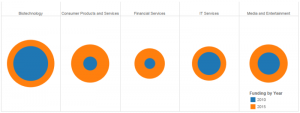All businesses today rely on data . But what type of data am I referring to and why is so much money being spent on “data?” The term “data” is actually very nebulous and can refer to just about anything — so it helps to contextualize the information I’m about to present.
. But what type of data am I referring to and why is so much money being spent on “data?” The term “data” is actually very nebulous and can refer to just about anything — so it helps to contextualize the information I’m about to present.
When I say “data” in the context of this post, I am talking about customer data. You’ll also read terms like “first-party” and “third-party” data, which will be explained throughout the piece.
To start, we’ll actually go straight to the end goal and talk about why brands care so much about customer data. The end goal I am referring to here is monetization. Businesses are trying to get to know their customers better so they can make more money. As “free” as the Internet seems, nothing is produced for free, and whether you as a consumer typically read the news or watch videos online, all of that content needs to be paid for. This is where customer data comes in.
You, as an Internet user, have a value to every digital property (website, mobile application, connected device, etc.) you interact with. That value grows as the quantity and quality of the customer data you provide to a digital property or to the property’s affiliates and partners increases. To that end, as you become more known within a website, the site can recommend more relevant products to you, surface content similar to what you usually read, or display ads about brands you like. All of these interactions are based on the amount of customer data these sites are able to access.
Does this sound scary? It really isn’t.
Take this example: you walk into a clothing retailer and look at a shirt. At this point, you have neither opened your mouth, nor have you engaged with a sales associate. Here is what the business knows about you right away: your gender, your age range, possibly your marital status, your location, and a product that interests you. That’s a lot of data! Having access to this information allows a store employee to walk up to you, greet you with the proper pronoun, and recommend additional products you might like.
Online retailers want the very same interaction, and that is where your customer data comes in.
 So what is all this “first-party versus third-party” data about? It comes down to how the information is collected. First-party data refers to data that you, yourself, choose to provide to a business. If you fill in a registration form with your email address, name, and any other required information, you’ve just supplied some first-party customer data. The business gained the data directly from you. Social network login and customizable registration options are particularly valuable because they help businesses acquire more data points that users have provided themselves — information such as Facebook Likes and interest data. Brands use this information to gain insights into who their customers really are, customer preferences, and which products are most appealing — whether that product is a T-shirt, an article, a video, etc.
So what is all this “first-party versus third-party” data about? It comes down to how the information is collected. First-party data refers to data that you, yourself, choose to provide to a business. If you fill in a registration form with your email address, name, and any other required information, you’ve just supplied some first-party customer data. The business gained the data directly from you. Social network login and customizable registration options are particularly valuable because they help businesses acquire more data points that users have provided themselves — information such as Facebook Likes and interest data. Brands use this information to gain insights into who their customers really are, customer preferences, and which products are most appealing — whether that product is a T-shirt, an article, a video, etc.
Third-party data then refers to customer data this is gained indirectly from an outside party. Take for example a business that does not have a registration system, but wishes to advertise to consumers in some way. The business can either integrate technologies on its digital properties that recognize visitors’ IP addresses, use tracking cookies placed within browsers, or implement other not-so-transparent mechanisms to help identify users. The business can also simply purchase large customer data sets that other businesses collect and provide at a cost. Typically, free tools that provide engagement functionality like sharing or commenting collect and then sell this data as a source of revenue.
By and large, third-party data is very readily available, but it is considered less valuable than first-party data when it comes to reaching users on a personal, one-to-one level. That’s because a lot of third-party information is assumed and based on things like browsing habits and web pages visited, rather than being explicitly provided by consumers. Very small percentages of third-party customer data are actually considered correct and reliable.
As a trend, more and more online users are finding value in registration and providing businesses with first-party data and insights into who they are as it relates to the websites they engage with. This is because businesses are getting smarter about how customer data is used. Brands are becoming more transparent with how they utilize customer data, and are providing more personalized experiences to their known customers as a clear value exchange.
This trend has given rise to the customer identity management industry as a whole. As businesses shift from assuming who their customers are to directly asking users for access to first-party customer data, they need technologies and strategies that make asking for and housing that customer data as seamless as possible.
Digital & Social Articles on Business 2 Community(130)
Report Post







